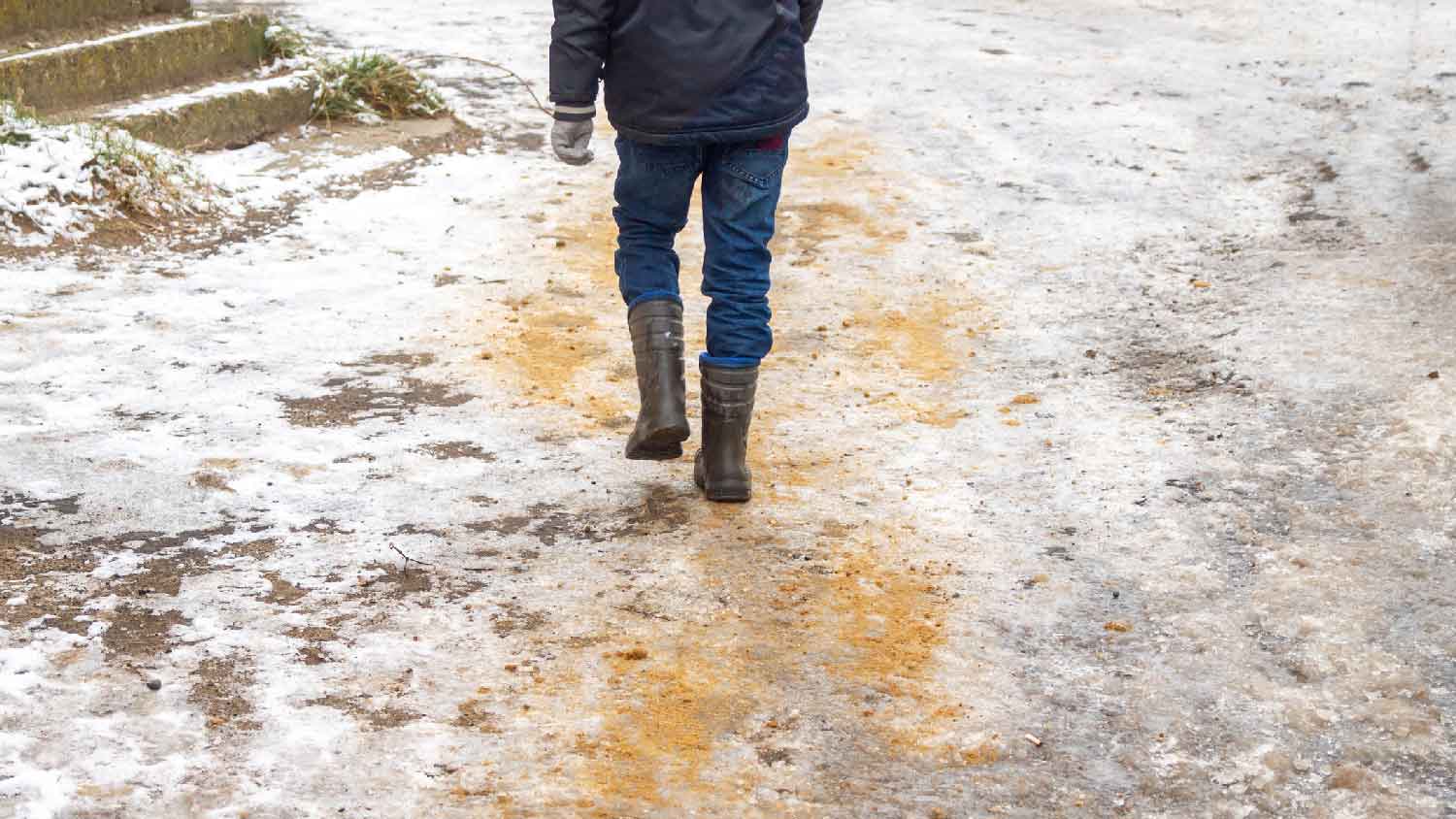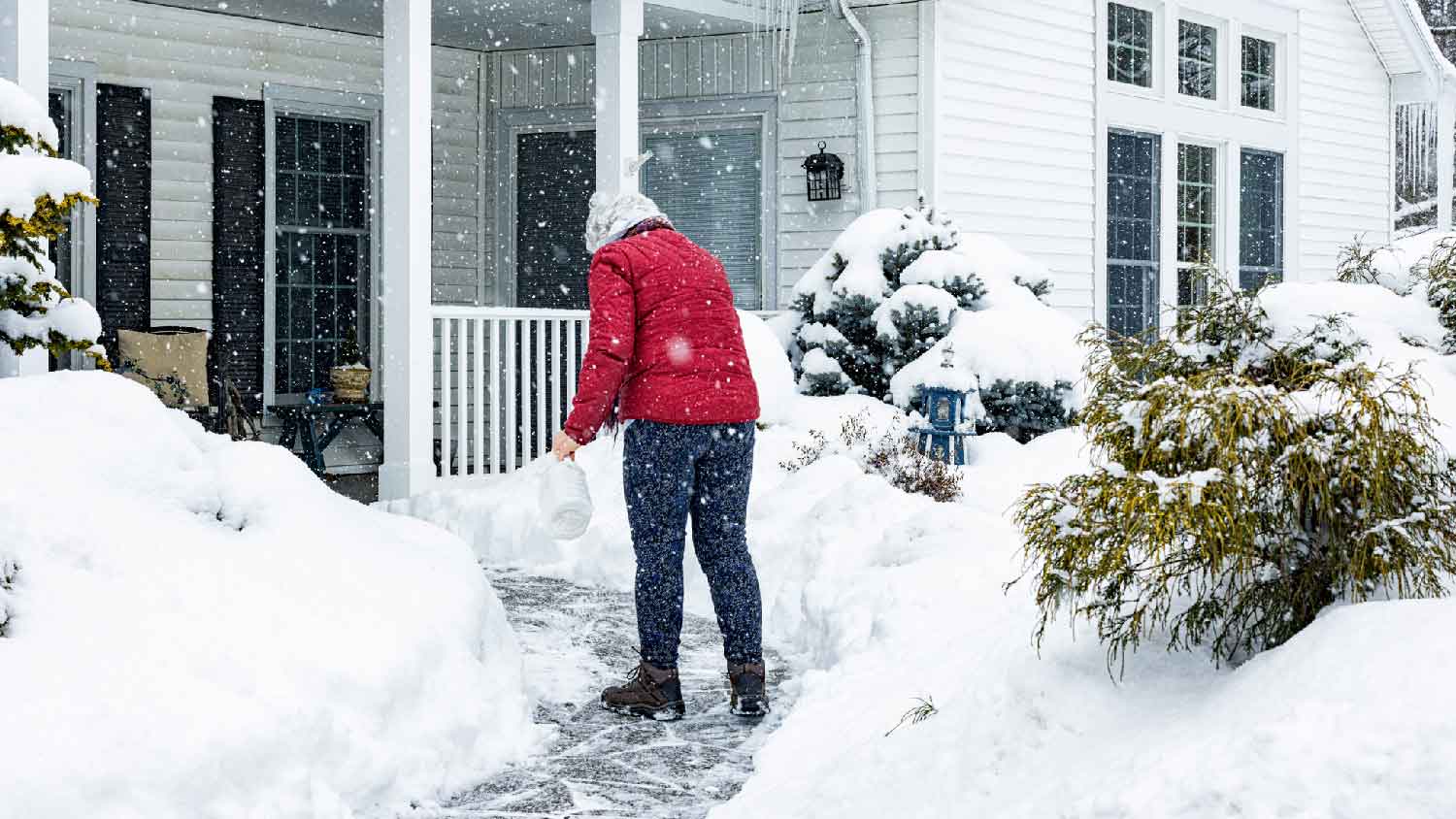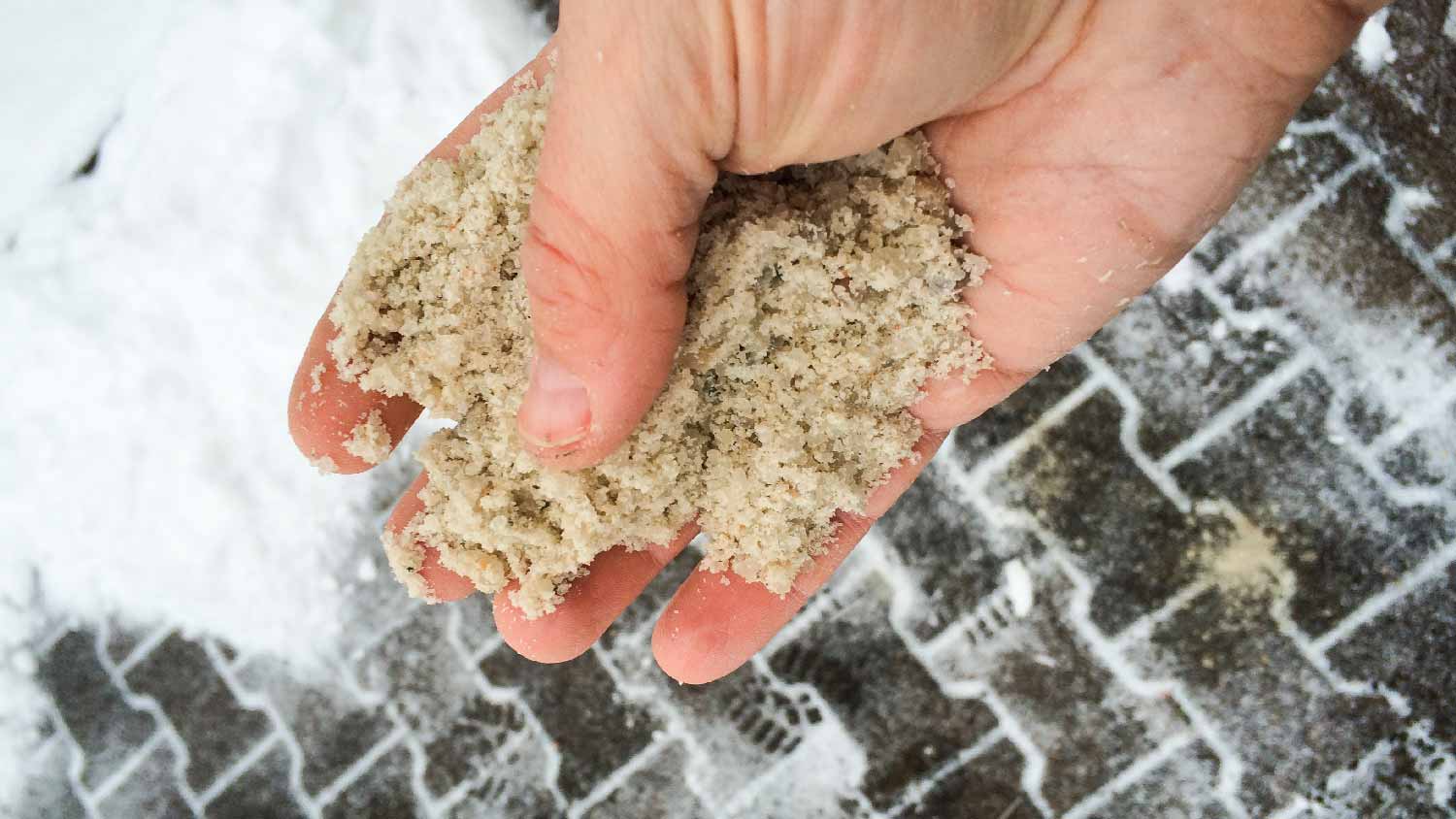
Discover the cost to install snow guards. Learn about average prices, key cost factors, and tips to save on your snow guard installation project.
Stay grounded this winter with these two slip-free solutions for ice and snow


Sand does not melt ice and snow, while rock salt does.
Sand provides better traction than rock salt.
Salt lowers the freezing point of water, causing ice to melt, whereas sand can only provide non-slip traction.
Rock salt can be harmful to the environment and can be toxic for plants and pets.
As if winter’s frigid temperatures weren’t treacherous enough, ice and snow can create a major safety hazard, leading homeowners to wonder whether to use sand or salt for snow removal.
From slips and falls to dangerous tire skids on the road, there are many reasons to address the slick areas on your property before they can cause a serious issue. Two of the most popular solutions are sand vs. salt for snow and ice, but which is the better option? Let’s take a look at how these two methods compare.
When it comes to using sand vs. salt for snow, sand improves traction on icy surfaces, while salt effectively melts snow and ice by lowering the freezing point of water. Sand is great for improving traction on icy surfaces, but it won't melt the snow or ice. This makes it ideal for areas where immediate grip is needed. On the other hand, salt effectively melts snow and ice, but it can be corrosive and harmful to the environment.

Sand is primarily used for traction on icy or snow-covered surfaces. Unlike salt, sand doesn't melt snow or ice, so it’s not an effective way to melt ice on your driveway, walkways, or roadways. Instead, it provides a gritty layer that prevents people from slipping. While it helps make roads and walkways safer in snowy and icy conditions, it requires consistent upkeep and isn’t an effective long-term solution.
| Pros | Cons |
|---|---|
| Improves traction | Doesn’t melt snow |
| Effective in very low temperatures | Needs frequent reapplication |
| Environmentally friendly | Can clog drainage systems |
Best for:
Areas with heavy foot or vehicle traffic
Extremely cold regions where salt is ineffective
Environments requiring non-corrosive solutions
Using sand for snow and ice can improve traction on icy surfaces due to its coarse texture, reducing the risk of slips and falls, especially in high-traffic areas like sidewalks and driveways. Unlike salt, which loses most of its effectiveness in extremely cold temperatures, sand does its job whatever the weather. Plus, sand is a natural and environmentally-friendly material that doesn't harm vegetation or pose a hazard to animals.
The main drawback of using sand for snow is that it doesn't have any melting properties, so it can't reduce ice thickness or aid in snow removal. While it provides traction for walkways, additional methods are needed to deal with the ice.
Another issue is the need for frequent reapplication, as sand can easily be covered by new snowfall or blown away by wind, reducing its effectiveness. Additionally, overusing sand can lead to clogged drainage systems, as it mixes with melted snow and may cause drainage problems during thawing periods.

Salt, specifically rock salt (sodium chloride), melts snow and ice. It works by lowering the freezing point of water, which breaks down ice and prevents new ice from forming.
| Pros | Cons |
|---|---|
| Melts snow and ice | Stains surfaces |
| Prevents ice formation | Corrosive to metals and concrete |
| Works quickly | Toxic to plants and animals |
Best for:
Areas where snow and ice melting is a priority
Urban settings with concrete or asphalt surfaces
Regions with frequent snowfall needing quick and efficient de-icing
Salt is effective at melting snow and ice, making it the ideal choice for quickly clearing roads and walkways in high-traffic areas. Another benefit is that salt is cost-effective and widely available, making it a more practical option for snow and ice management. Spreading salt before a snowfall can also prevent ice from forming, making clean-up easier.
Salt can leave unsightly white residue on surfaces like concrete, asphalt, clothing, and even indoor floors if tracked inside. The hard salt crystals can scratch wood and tile flooring or leave behind tiny dings and indentations, so “no shoes” should be a mandatory winter indoor policy. On top of that, prolonged use of salt can lead to corrosion of metal surfaces and potential damage to concrete.
The environmental impact and safety risks of rock salt are another significant drawback, especially in residential areas with lots of green space. Salt is toxic to plants and animals, harming vegetation by altering soil chemistry and posing a risk to pets if ingested. Considering salt can irritate pet paws, causing them to lick, it’s important to protect paws with booties or wash them as soon as you get inside.

Consider these qualities when you’re deciding whether to use sand or ice to address the snow and ice on your property.
Neither sand nor salt is aesthetically pleasing—but then again, neither is the gray, slushy snow and ice on your walkway. All that aside, unlike salt, sand doesn’t leave a crusty white residue on your shoes, clothing, vehicle, or property, so it wins in this category.
In terms of cost by volume, sand is the more budget-friendly option. A 50-pound bag of basic play sand typically goes for $5 to $7, while a 50-pound bag of rock salt costs anywhere from $11 to $30 or more depending on brand and type of salt. Keep in mind that you may need to apply sand in larger quantities and more often, so this can impact the bigger picture of your total cost.
In general, salt is more readily available than sand. Sand is usually only stocked in home improvement stores and some big-box retail stores. Salt, being the more popular option for snow and ice, is often stocked in most retail stores and convenience stores.
Salt melts snow and ice, while sand does not. The reason salt melts ice is that it lowers the freezing point of water, which helps to break down ice and prevent new ice from forming. This makes salt the superior choice for reducing ice thickness, as well as preventing the accumulation of more ice.
However, in extremely cold temperatures, ice can remain solid, rendering salt ineffective. Rock salt only works in temperatures 5 degrees Fahrenheit and above. Under these conditions, the better solution would be relying on sand for enhanced traction. Alternatively, you could choose ice melt instead of rock salt, which contains stronger chemical agents that can melt ice in temperatures as low as -15 degrees Fahrenheit.
Sand provides immediate traction on icy surfaces, which is crucial for preventing slips and falls. Salt, while it does have hard crystals for some traction, does not offer the same level of grip.
Sand is only effective when it's on the surface of the ice; if it becomes buried under snow, it needs to be applied again. Salt is longer lasting than sand, as it melts the ice and prevents the formation of new ice. Still, it requires consistency in application, which can be quite a bother when it’s cold out. If you’re having trouble keeping snow and ice at bay, get in touch with a local snow removal company to ensure your property stays safe (and you stay warm).
Sand is a natural and environmentally friendly material, posing no harm to plants or animals. On the other hand, salt can alter the delicate chemical composition of soil, which can be detrimental to plants. The Environmental Protection Agency (EPA) also warns that excessive amounts of road salt can contaminate drinking water and harm aquatic life due to high sodium and chloride levels.
While there’s no perfect solution yet, it’s important to be mindful of this risk and limit the use of salt where possible. Calcium chloride (as opposed to sodium chloride, a.k.a common road salt), is one of the best ways to melt ice on your driveway and walkways, as it’s much safer for the environment and won’t damage your lawn or plants. Other safer alternatives to melt ice without salt include natural materials such as sugar beet juice, plant fertilizer, and even coffee grounds.
From average costs to expert advice, get all the answers you need to get your job done.

Discover the cost to install snow guards. Learn about average prices, key cost factors, and tips to save on your snow guard installation project.

Get the latest snow removal cost estimates, including average prices, key cost factors, and tips to help homeowners budget for safe, efficient snow removal.

Use our guide to learn how to use a snowblower so that your driveway, sidewalk, and front entry are hazard-free throughout the winter.

What’s the difference between a three-stage vs two-stage snow blower and which is better? Learn which option is best for your snow removal needs.

There are some things that everyone should know before hiring a professional snow removal service this winter. This list of tips breaks them down for you.

There are several ways to melt ice on driveways, including with and without salt. Read this tutorial on how to melt ice on driveways to get started.